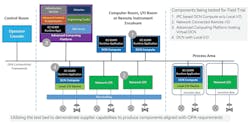Even as more recent testbed projects start to snowball, ExxonMobil’s pioneering testbed project and upcoming field trial is still out in front, serving as a model and inspiration for the others.
“There’s a lot of data processing and other capabilities available at the edge, and we see Open Process Automation (OPA) as a platform that can give us many useful functions now and in the future. I view my new automation role as part of that digital transformation journey,” says Ryan Smeltzer, OPA program manager at ExxonMobil Technology and Engineering Co. (EMTEC) in Houston. “We created EMTEC a year ago to combine our research and engineering resources from across the corporation, and magnify their capabilities to better support our upstream, heritage downstream, chemicals and other businesses. This lets our engineers focus their know-how be used on the highest-priority operations and challenges without being siloed along organizational lines, and accelerates everyone’s learning about R&D programs, such as our OPA program’s testbed and field trial.”
ExxonMobil was a founding member of the Open Process Automation Forum that’s been developing the Open Process Automation Standard (O-PAS). During 2017-20, ExxonMobil executed a proof-of-concept (PoC) that stitched together heterogeneous components from different vendors. It also commissioned and operated a prototype OPA system on a pilot plant in New Jersey, and commissioned its OPA Testbed Lab near Houston from 2019 to the present. These initial experiments enabled ExxonMobil, system integrator Yokogawa and their partners to integrate, test and qualify a growing group of products conforming to O-PAS, V2.1, and meeting ExxonMobil’s requirements for field use.
All of this testing and experience went into developing ExxonMobil’s design for its field trial, which recently completed front-end engineering and design (FEED), and is now at the detailed design stage. ExxonMobil plans to conduct its FAT this summer, and expects to start running the field trial before the end of the year at an ExxonMobil chemical facility in Baton Rouge, LA. At about 20 times larger than the pilot, the field trial has about 2,500 I/O points and about 100 loops.
Enjoying interchangeability
While its testbed and field trial look like any other process automation application, differences and advantages due to OPA quickly become apparent.
“The testbed is wrapping up validation of the software and hardware components we’ll use to assemble an OPA architecture for the field trial—and eventually build automation systems that will run in our plants for years,” says David DeBari, OPA technical team leader at EMTEC and co-chair of OPAF’s application portability subcommittee. “The field trial is a risk-appropriate application and typical brownfield migration to new controls. We’re replacing an existing DCS and a handful of obsolete PLCs, but this time we’re moving to an OPA-based open architecture, which is also networked with standard Ethernet, lots of OPC UA protocol, and some legacy serial communications. This looks like a regular DCS migration project, but the difference now is it’s enabled by standards that provide interoperability and interchangeability.”
Similar to most process industry end users, DeBari reports that ExxonMobil was traditionally constrained by proprietary controls and other technology from its suppliers. “We had to use the same Brand X for I/O, controllers and software. Now, we have the choice of using Brand X software, Brand Y I/O and Brand Z controllers, and getting the best features for each,” he explains. “Sticking to standards like O-PAS can give us plug-and-play interoperability, no more proprietary lockouts or lock-ins, and our choice of products that fulfill our requirements. We used to see all the choices available in mainstream consumer areas like cellular, audio and video technologies, and we wanted that level of choice in our process controls and other industrial technologies. For example, with our cellular phones, we can use any device with our service provider. This capability comes with standardization. The old idea of requiring homogenous I/O, PLCs and software is long gone.”
DeBari adds the benefits of standards like O-PAS and having more choices go beyond simply picking desirable parts because users can also tailor their equipment more closely to what their processes require.
“This isn’t just choosing small, medium, large and extra-large clothing, or good, better and best devices,” says DeBari. “Standards and choice mean we can decide whether we need to spend on advanced capabilities or not. A simple machine isn’t likely to need artificial intelligence (AI), and having more choice means we don’t have to put in more than we need. The process controls and automation industry should accommodate all of us users from large ones like ExxonMobil to the smallest manufacturer, so each one can decide what they want and how much without being constrained by their vendors.”
Share and share alike
Smeltzer reports that whatever ExxonMobil and its partners learn from the field trial will be shared with whoever wants to learn about OPA and use it to gain momentum towards a building a marketplace. “Our intent is to drive technology forward for our industry and add value to our business, but we need to do it in a reliable and robust manner for the lives of our assets,” explains Smeltzer. “The first commercial application of OPA is our field trial in Baton Rouge, which focuses on improving performance and adding value for this manufacturing plant. These OPA program development activities have taken seven years, cost millions of dollars and require a lot of sweat equity, but we’re willing share what we’re learning and add to everyone’s investment in the automation space.”
Smetlzer adds the field trial’s components will also perform analytics at the edge—next to sensors gathering data. “All of this is underpinned by O-PAS, which is why we need to keep pushing for commercialization, conforming O-PAS products, and keeping the standard updated,” says Smeltzer. “All of this requires investment, whether it’s in the kit and controls for the testbed or in the hands-on efforts of our people. We want to perform these operations better and cheaper, so we have to be convinced there’s value is proposed solutions. Well, ExxonMobil is convinced that O-PAS has value, and that’s why we and our partners invest in it, and it’s why we’re encouraging other potential users, companies and organizations to do the same.”
DeBari adds, “We never wanted to build an ExxonMobil-only automation system or even one that was just for oil and gas. Open process automation can also be used by discrete manufacturers canning soup, bottling beer, making paper or producing pharmaceuticals. We want OPA to be open and usable by everyone in all industries and anyone who needs additional value from automation. That’s why our field trial is a demonstration, and others like the nine end-user collaboration partners in OPAF are invited to learn about it, join in, and conduct their own field trials. O-PAS standardizes interfaces and technologies for industrial automation devices and applications. This means we’re not reinventing the wheel every time, and our processes can be made from pieces that already exist.”
About the Author

Leaders relevant to this article:

